Patient Experience and Falls Prevention: NUR1201 Essay, S2 2018
VerifiedAdded on 2023/06/04
|8
|1928
|482
Essay
AI Summary
This essay, written by a nursing student, delves into the critical aspects of patient experience and falls prevention within a healthcare setting. The assignment utilizes a case study of a 75-year-old man, Mr. William Taylor, who experienced a fall while exercising and has multiple medical conditions. The student employs the Gibbs reflective cycle to analyze the scenario, exploring the patient's feelings, thoughts, values, and beliefs regarding his care, including past negative experiences in public hospitals. The essay examines the concepts of negligence, competence, and quality of care, highlighting instances of both inadequate and adequate care. It emphasizes the importance of patient knowledge, effective communication, and proactive strategies to prevent falls. The conclusion underscores the benefits of understanding patient experiences and partnering with patients to improve healthcare outcomes, referencing national safety and quality health service standards.

Nursing
Student’s name:
Institutional:
Student’s name:
Institutional:
Paraphrase This Document
Need a fresh take? Get an instant paraphrase of this document with our AI Paraphraser
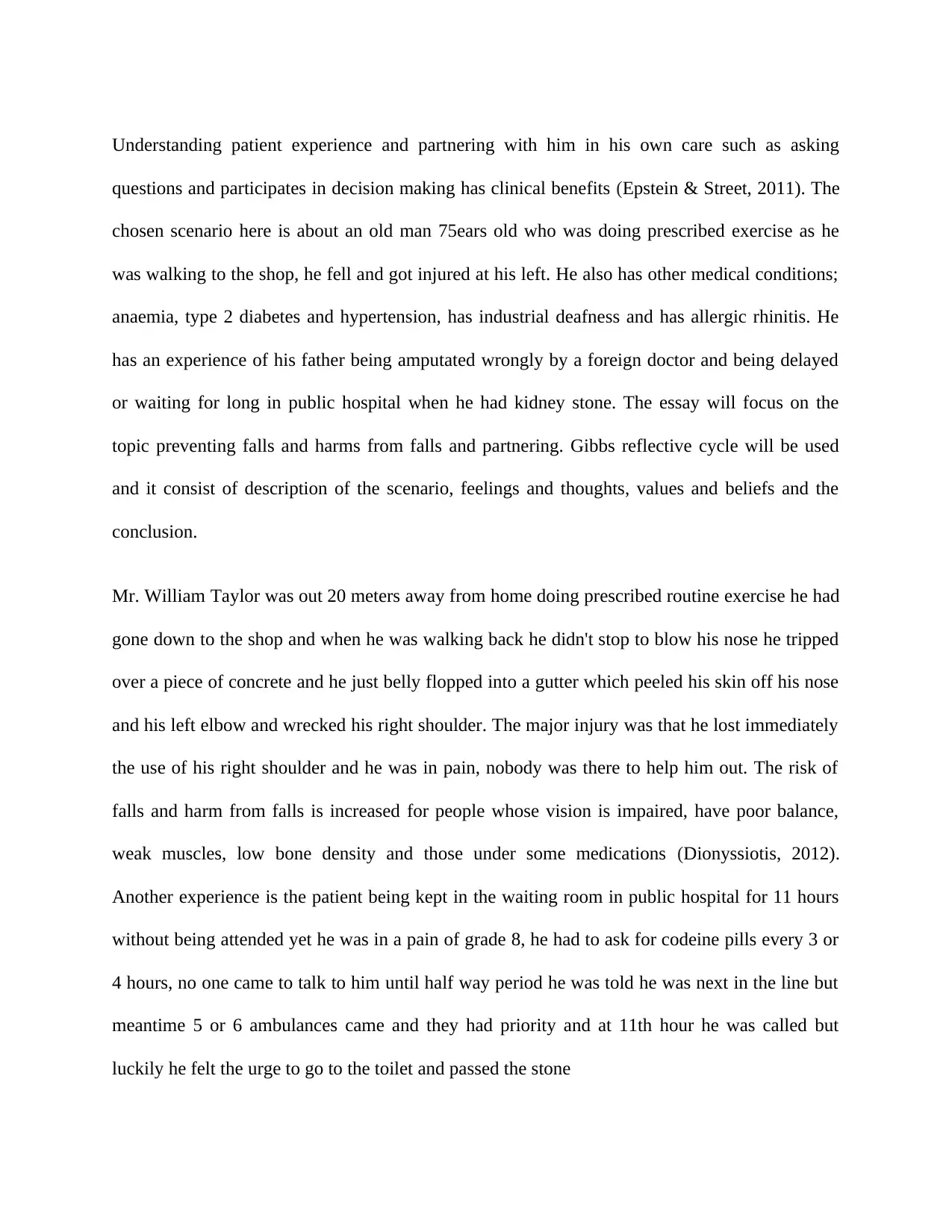
Understanding patient experience and partnering with him in his own care such as asking
questions and participates in decision making has clinical benefits (Epstein & Street, 2011). The
chosen scenario here is about an old man 75ears old who was doing prescribed exercise as he
was walking to the shop, he fell and got injured at his left. He also has other medical conditions;
anaemia, type 2 diabetes and hypertension, has industrial deafness and has allergic rhinitis. He
has an experience of his father being amputated wrongly by a foreign doctor and being delayed
or waiting for long in public hospital when he had kidney stone. The essay will focus on the
topic preventing falls and harms from falls and partnering. Gibbs reflective cycle will be used
and it consist of description of the scenario, feelings and thoughts, values and beliefs and the
conclusion.
Mr. William Taylor was out 20 meters away from home doing prescribed routine exercise he had
gone down to the shop and when he was walking back he didn't stop to blow his nose he tripped
over a piece of concrete and he just belly flopped into a gutter which peeled his skin off his nose
and his left elbow and wrecked his right shoulder. The major injury was that he lost immediately
the use of his right shoulder and he was in pain, nobody was there to help him out. The risk of
falls and harm from falls is increased for people whose vision is impaired, have poor balance,
weak muscles, low bone density and those under some medications (Dionyssiotis, 2012).
Another experience is the patient being kept in the waiting room in public hospital for 11 hours
without being attended yet he was in a pain of grade 8, he had to ask for codeine pills every 3 or
4 hours, no one came to talk to him until half way period he was told he was next in the line but
meantime 5 or 6 ambulances came and they had priority and at 11th hour he was called but
luckily he felt the urge to go to the toilet and passed the stone
questions and participates in decision making has clinical benefits (Epstein & Street, 2011). The
chosen scenario here is about an old man 75ears old who was doing prescribed exercise as he
was walking to the shop, he fell and got injured at his left. He also has other medical conditions;
anaemia, type 2 diabetes and hypertension, has industrial deafness and has allergic rhinitis. He
has an experience of his father being amputated wrongly by a foreign doctor and being delayed
or waiting for long in public hospital when he had kidney stone. The essay will focus on the
topic preventing falls and harms from falls and partnering. Gibbs reflective cycle will be used
and it consist of description of the scenario, feelings and thoughts, values and beliefs and the
conclusion.
Mr. William Taylor was out 20 meters away from home doing prescribed routine exercise he had
gone down to the shop and when he was walking back he didn't stop to blow his nose he tripped
over a piece of concrete and he just belly flopped into a gutter which peeled his skin off his nose
and his left elbow and wrecked his right shoulder. The major injury was that he lost immediately
the use of his right shoulder and he was in pain, nobody was there to help him out. The risk of
falls and harm from falls is increased for people whose vision is impaired, have poor balance,
weak muscles, low bone density and those under some medications (Dionyssiotis, 2012).
Another experience is the patient being kept in the waiting room in public hospital for 11 hours
without being attended yet he was in a pain of grade 8, he had to ask for codeine pills every 3 or
4 hours, no one came to talk to him until half way period he was told he was next in the line but
meantime 5 or 6 ambulances came and they had priority and at 11th hour he was called but
luckily he felt the urge to go to the toilet and passed the stone
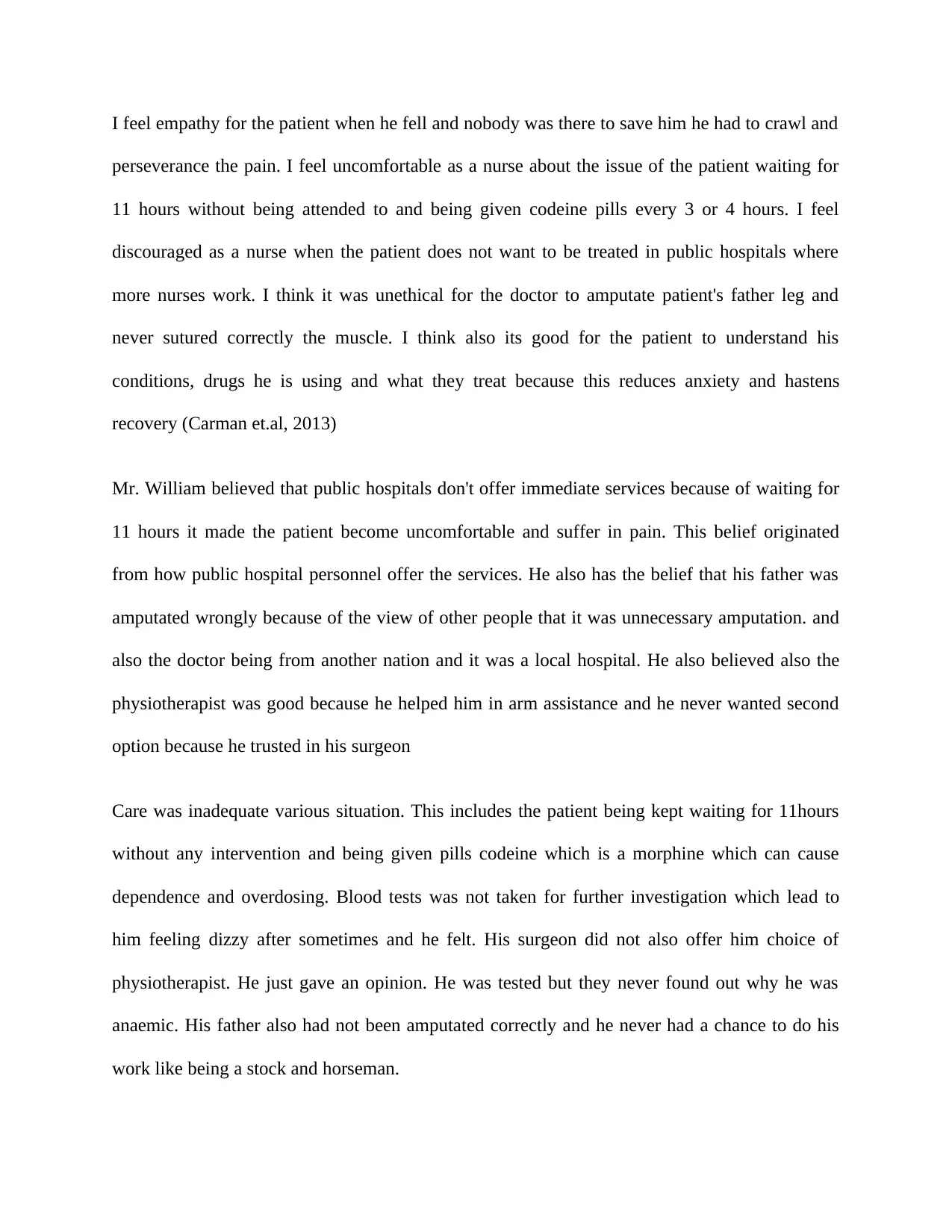
I feel empathy for the patient when he fell and nobody was there to save him he had to crawl and
perseverance the pain. I feel uncomfortable as a nurse about the issue of the patient waiting for
11 hours without being attended to and being given codeine pills every 3 or 4 hours. I feel
discouraged as a nurse when the patient does not want to be treated in public hospitals where
more nurses work. I think it was unethical for the doctor to amputate patient's father leg and
never sutured correctly the muscle. I think also its good for the patient to understand his
conditions, drugs he is using and what they treat because this reduces anxiety and hastens
recovery (Carman et.al, 2013)
Mr. William believed that public hospitals don't offer immediate services because of waiting for
11 hours it made the patient become uncomfortable and suffer in pain. This belief originated
from how public hospital personnel offer the services. He also has the belief that his father was
amputated wrongly because of the view of other people that it was unnecessary amputation. and
also the doctor being from another nation and it was a local hospital. He also believed also the
physiotherapist was good because he helped him in arm assistance and he never wanted second
option because he trusted in his surgeon
Care was inadequate various situation. This includes the patient being kept waiting for 11hours
without any intervention and being given pills codeine which is a morphine which can cause
dependence and overdosing. Blood tests was not taken for further investigation which lead to
him feeling dizzy after sometimes and he felt. His surgeon did not also offer him choice of
physiotherapist. He just gave an opinion. He was tested but they never found out why he was
anaemic. His father also had not been amputated correctly and he never had a chance to do his
work like being a stock and horseman.
perseverance the pain. I feel uncomfortable as a nurse about the issue of the patient waiting for
11 hours without being attended to and being given codeine pills every 3 or 4 hours. I feel
discouraged as a nurse when the patient does not want to be treated in public hospitals where
more nurses work. I think it was unethical for the doctor to amputate patient's father leg and
never sutured correctly the muscle. I think also its good for the patient to understand his
conditions, drugs he is using and what they treat because this reduces anxiety and hastens
recovery (Carman et.al, 2013)
Mr. William believed that public hospitals don't offer immediate services because of waiting for
11 hours it made the patient become uncomfortable and suffer in pain. This belief originated
from how public hospital personnel offer the services. He also has the belief that his father was
amputated wrongly because of the view of other people that it was unnecessary amputation. and
also the doctor being from another nation and it was a local hospital. He also believed also the
physiotherapist was good because he helped him in arm assistance and he never wanted second
option because he trusted in his surgeon
Care was inadequate various situation. This includes the patient being kept waiting for 11hours
without any intervention and being given pills codeine which is a morphine which can cause
dependence and overdosing. Blood tests was not taken for further investigation which lead to
him feeling dizzy after sometimes and he felt. His surgeon did not also offer him choice of
physiotherapist. He just gave an opinion. He was tested but they never found out why he was
anaemic. His father also had not been amputated correctly and he never had a chance to do his
work like being a stock and horseman.
⊘ This is a preview!⊘
Do you want full access?
Subscribe today to unlock all pages.

Trusted by 1+ million students worldwide
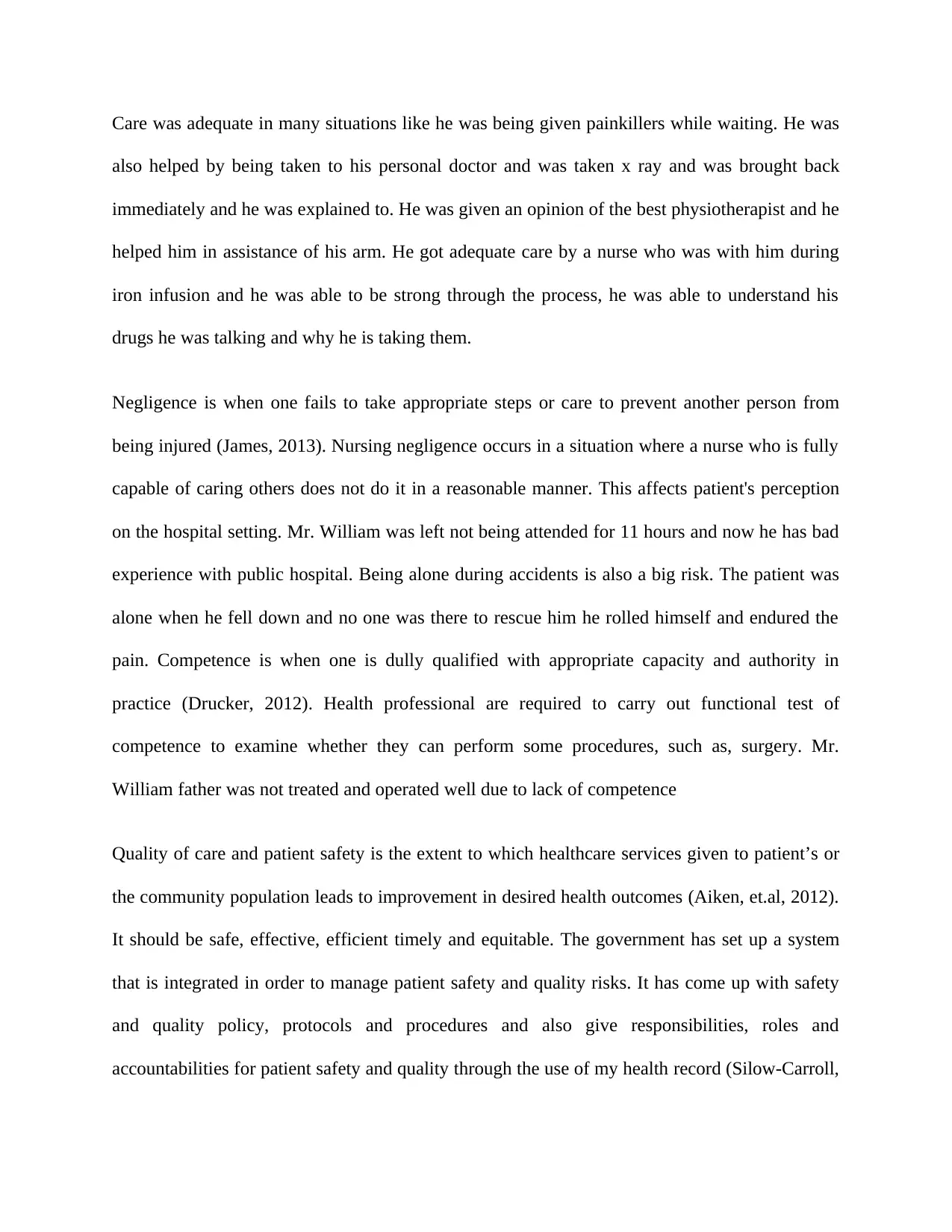
Care was adequate in many situations like he was being given painkillers while waiting. He was
also helped by being taken to his personal doctor and was taken x ray and was brought back
immediately and he was explained to. He was given an opinion of the best physiotherapist and he
helped him in assistance of his arm. He got adequate care by a nurse who was with him during
iron infusion and he was able to be strong through the process, he was able to understand his
drugs he was talking and why he is taking them.
Negligence is when one fails to take appropriate steps or care to prevent another person from
being injured (James, 2013). Nursing negligence occurs in a situation where a nurse who is fully
capable of caring others does not do it in a reasonable manner. This affects patient's perception
on the hospital setting. Mr. William was left not being attended for 11 hours and now he has bad
experience with public hospital. Being alone during accidents is also a big risk. The patient was
alone when he fell down and no one was there to rescue him he rolled himself and endured the
pain. Competence is when one is dully qualified with appropriate capacity and authority in
practice (Drucker, 2012). Health professional are required to carry out functional test of
competence to examine whether they can perform some procedures, such as, surgery. Mr.
William father was not treated and operated well due to lack of competence
Quality of care and patient safety is the extent to which healthcare services given to patient’s or
the community population leads to improvement in desired health outcomes (Aiken, et.al, 2012).
It should be safe, effective, efficient timely and equitable. The government has set up a system
that is integrated in order to manage patient safety and quality risks. It has come up with safety
and quality policy, protocols and procedures and also give responsibilities, roles and
accountabilities for patient safety and quality through the use of my health record (Silow-Carroll,
also helped by being taken to his personal doctor and was taken x ray and was brought back
immediately and he was explained to. He was given an opinion of the best physiotherapist and he
helped him in assistance of his arm. He got adequate care by a nurse who was with him during
iron infusion and he was able to be strong through the process, he was able to understand his
drugs he was talking and why he is taking them.
Negligence is when one fails to take appropriate steps or care to prevent another person from
being injured (James, 2013). Nursing negligence occurs in a situation where a nurse who is fully
capable of caring others does not do it in a reasonable manner. This affects patient's perception
on the hospital setting. Mr. William was left not being attended for 11 hours and now he has bad
experience with public hospital. Being alone during accidents is also a big risk. The patient was
alone when he fell down and no one was there to rescue him he rolled himself and endured the
pain. Competence is when one is dully qualified with appropriate capacity and authority in
practice (Drucker, 2012). Health professional are required to carry out functional test of
competence to examine whether they can perform some procedures, such as, surgery. Mr.
William father was not treated and operated well due to lack of competence
Quality of care and patient safety is the extent to which healthcare services given to patient’s or
the community population leads to improvement in desired health outcomes (Aiken, et.al, 2012).
It should be safe, effective, efficient timely and equitable. The government has set up a system
that is integrated in order to manage patient safety and quality risks. It has come up with safety
and quality policy, protocols and procedures and also give responsibilities, roles and
accountabilities for patient safety and quality through the use of my health record (Silow-Carroll,
Paraphrase This Document
Need a fresh take? Get an instant paraphrase of this document with our AI Paraphraser
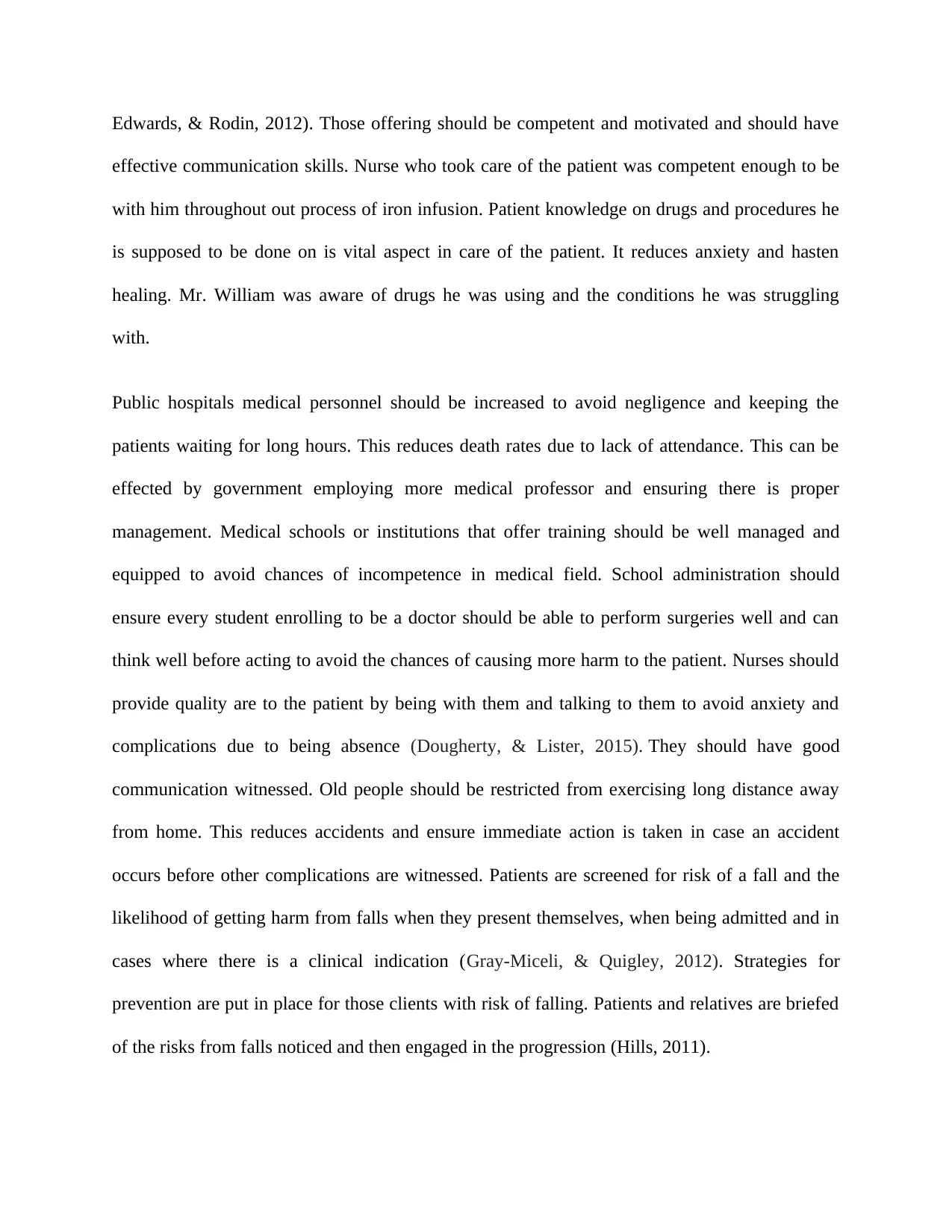
Edwards, & Rodin, 2012). Those offering should be competent and motivated and should have
effective communication skills. Nurse who took care of the patient was competent enough to be
with him throughout out process of iron infusion. Patient knowledge on drugs and procedures he
is supposed to be done on is vital aspect in care of the patient. It reduces anxiety and hasten
healing. Mr. William was aware of drugs he was using and the conditions he was struggling
with.
Public hospitals medical personnel should be increased to avoid negligence and keeping the
patients waiting for long hours. This reduces death rates due to lack of attendance. This can be
effected by government employing more medical professor and ensuring there is proper
management. Medical schools or institutions that offer training should be well managed and
equipped to avoid chances of incompetence in medical field. School administration should
ensure every student enrolling to be a doctor should be able to perform surgeries well and can
think well before acting to avoid the chances of causing more harm to the patient. Nurses should
provide quality are to the patient by being with them and talking to them to avoid anxiety and
complications due to being absence (Dougherty, & Lister, 2015). They should have good
communication witnessed. Old people should be restricted from exercising long distance away
from home. This reduces accidents and ensure immediate action is taken in case an accident
occurs before other complications are witnessed. Patients are screened for risk of a fall and the
likelihood of getting harm from falls when they present themselves, when being admitted and in
cases where there is a clinical indication (Gray-Miceli, & Quigley, 2012). Strategies for
prevention are put in place for those clients with risk of falling. Patients and relatives are briefed
of the risks from falls noticed and then engaged in the progression (Hills, 2011).
effective communication skills. Nurse who took care of the patient was competent enough to be
with him throughout out process of iron infusion. Patient knowledge on drugs and procedures he
is supposed to be done on is vital aspect in care of the patient. It reduces anxiety and hasten
healing. Mr. William was aware of drugs he was using and the conditions he was struggling
with.
Public hospitals medical personnel should be increased to avoid negligence and keeping the
patients waiting for long hours. This reduces death rates due to lack of attendance. This can be
effected by government employing more medical professor and ensuring there is proper
management. Medical schools or institutions that offer training should be well managed and
equipped to avoid chances of incompetence in medical field. School administration should
ensure every student enrolling to be a doctor should be able to perform surgeries well and can
think well before acting to avoid the chances of causing more harm to the patient. Nurses should
provide quality are to the patient by being with them and talking to them to avoid anxiety and
complications due to being absence (Dougherty, & Lister, 2015). They should have good
communication witnessed. Old people should be restricted from exercising long distance away
from home. This reduces accidents and ensure immediate action is taken in case an accident
occurs before other complications are witnessed. Patients are screened for risk of a fall and the
likelihood of getting harm from falls when they present themselves, when being admitted and in
cases where there is a clinical indication (Gray-Miceli, & Quigley, 2012). Strategies for
prevention are put in place for those clients with risk of falling. Patients and relatives are briefed
of the risks from falls noticed and then engaged in the progression (Hills, 2011).
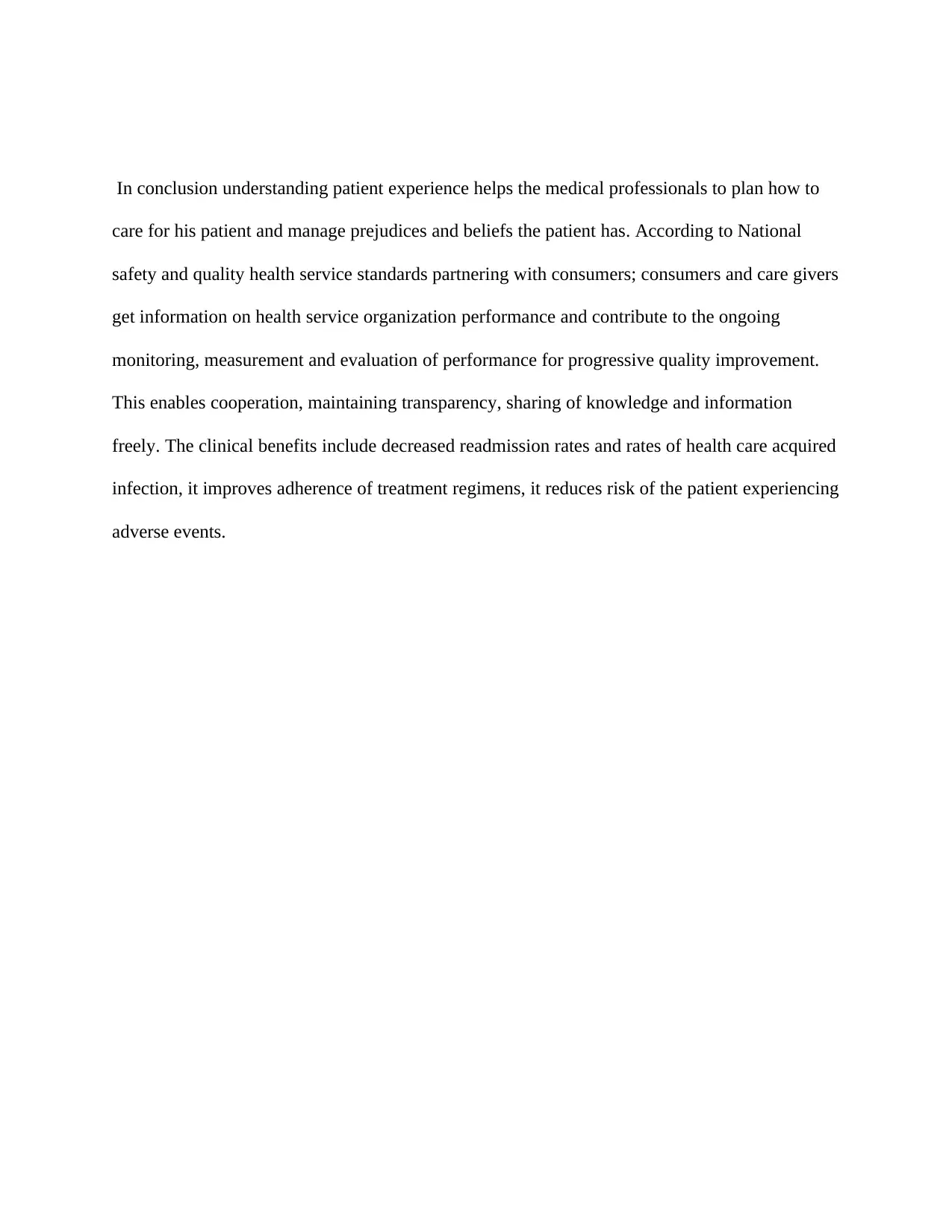
In conclusion understanding patient experience helps the medical professionals to plan how to
care for his patient and manage prejudices and beliefs the patient has. According to National
safety and quality health service standards partnering with consumers; consumers and care givers
get information on health service organization performance and contribute to the ongoing
monitoring, measurement and evaluation of performance for progressive quality improvement.
This enables cooperation, maintaining transparency, sharing of knowledge and information
freely. The clinical benefits include decreased readmission rates and rates of health care acquired
infection, it improves adherence of treatment regimens, it reduces risk of the patient experiencing
adverse events.
care for his patient and manage prejudices and beliefs the patient has. According to National
safety and quality health service standards partnering with consumers; consumers and care givers
get information on health service organization performance and contribute to the ongoing
monitoring, measurement and evaluation of performance for progressive quality improvement.
This enables cooperation, maintaining transparency, sharing of knowledge and information
freely. The clinical benefits include decreased readmission rates and rates of health care acquired
infection, it improves adherence of treatment regimens, it reduces risk of the patient experiencing
adverse events.
⊘ This is a preview!⊘
Do you want full access?
Subscribe today to unlock all pages.

Trusted by 1+ million students worldwide
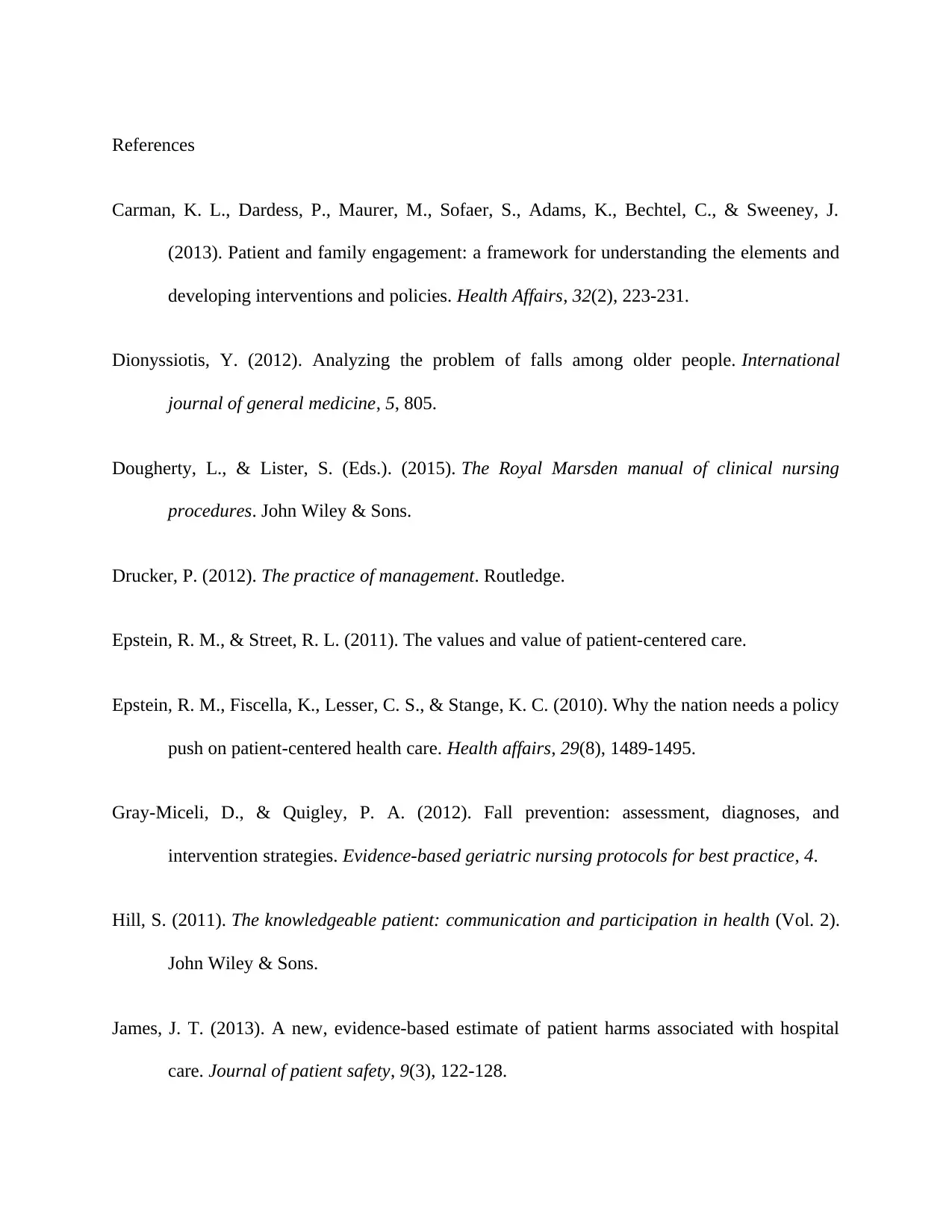
References
Carman, K. L., Dardess, P., Maurer, M., Sofaer, S., Adams, K., Bechtel, C., & Sweeney, J.
(2013). Patient and family engagement: a framework for understanding the elements and
developing interventions and policies. Health Affairs, 32(2), 223-231.
Dionyssiotis, Y. (2012). Analyzing the problem of falls among older people. International
journal of general medicine, 5, 805.
Dougherty, L., & Lister, S. (Eds.). (2015). The Royal Marsden manual of clinical nursing
procedures. John Wiley & Sons.
Drucker, P. (2012). The practice of management. Routledge.
Epstein, R. M., & Street, R. L. (2011). The values and value of patient-centered care.
Epstein, R. M., Fiscella, K., Lesser, C. S., & Stange, K. C. (2010). Why the nation needs a policy
push on patient-centered health care. Health affairs, 29(8), 1489-1495.
Gray-Miceli, D., & Quigley, P. A. (2012). Fall prevention: assessment, diagnoses, and
intervention strategies. Evidence-based geriatric nursing protocols for best practice, 4.
Hill, S. (2011). The knowledgeable patient: communication and participation in health (Vol. 2).
John Wiley & Sons.
James, J. T. (2013). A new, evidence-based estimate of patient harms associated with hospital
care. Journal of patient safety, 9(3), 122-128.
Carman, K. L., Dardess, P., Maurer, M., Sofaer, S., Adams, K., Bechtel, C., & Sweeney, J.
(2013). Patient and family engagement: a framework for understanding the elements and
developing interventions and policies. Health Affairs, 32(2), 223-231.
Dionyssiotis, Y. (2012). Analyzing the problem of falls among older people. International
journal of general medicine, 5, 805.
Dougherty, L., & Lister, S. (Eds.). (2015). The Royal Marsden manual of clinical nursing
procedures. John Wiley & Sons.
Drucker, P. (2012). The practice of management. Routledge.
Epstein, R. M., & Street, R. L. (2011). The values and value of patient-centered care.
Epstein, R. M., Fiscella, K., Lesser, C. S., & Stange, K. C. (2010). Why the nation needs a policy
push on patient-centered health care. Health affairs, 29(8), 1489-1495.
Gray-Miceli, D., & Quigley, P. A. (2012). Fall prevention: assessment, diagnoses, and
intervention strategies. Evidence-based geriatric nursing protocols for best practice, 4.
Hill, S. (2011). The knowledgeable patient: communication and participation in health (Vol. 2).
John Wiley & Sons.
James, J. T. (2013). A new, evidence-based estimate of patient harms associated with hospital
care. Journal of patient safety, 9(3), 122-128.
Paraphrase This Document
Need a fresh take? Get an instant paraphrase of this document with our AI Paraphraser
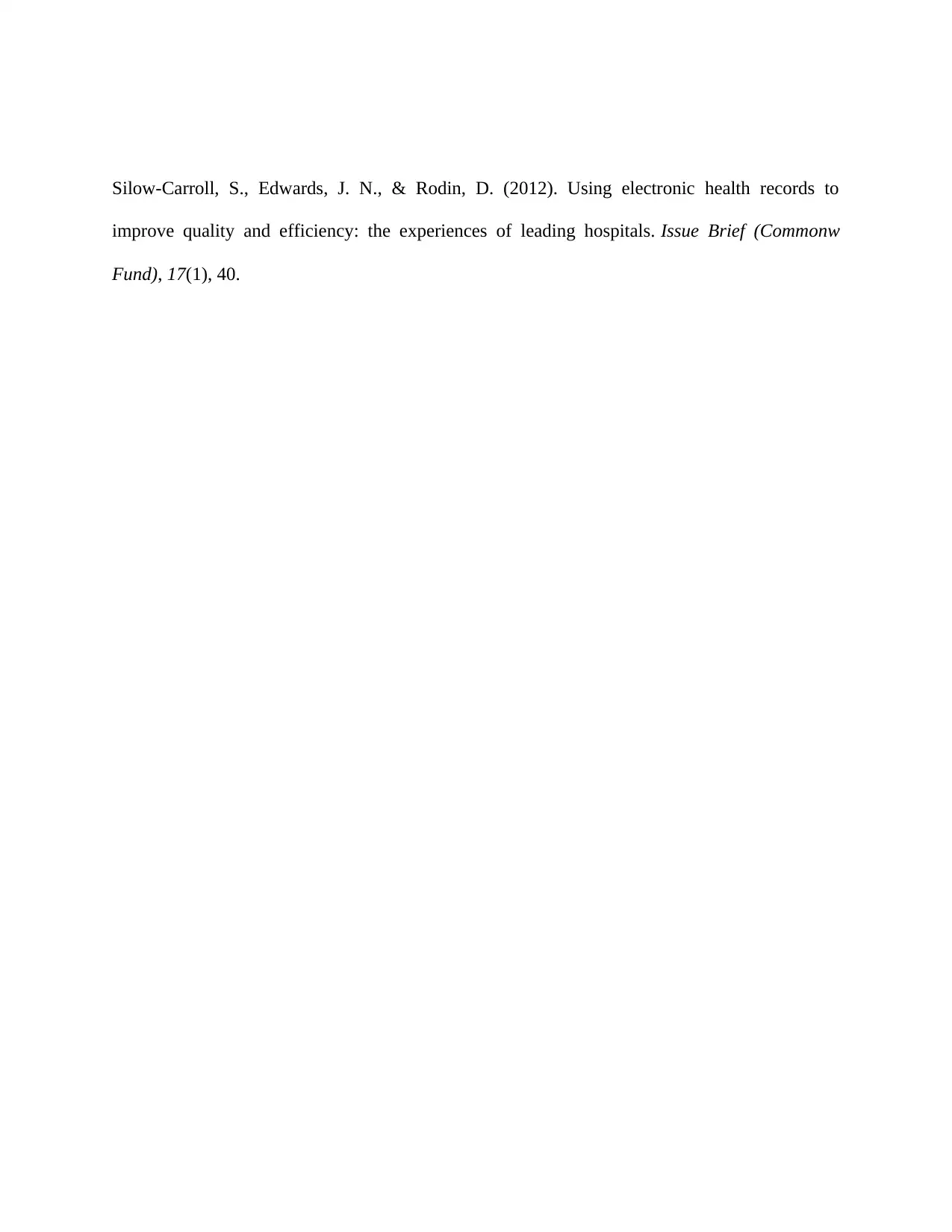
Silow-Carroll, S., Edwards, J. N., & Rodin, D. (2012). Using electronic health records to
improve quality and efficiency: the experiences of leading hospitals. Issue Brief (Commonw
Fund), 17(1), 40.
improve quality and efficiency: the experiences of leading hospitals. Issue Brief (Commonw
Fund), 17(1), 40.
1 out of 8
Related Documents
Your All-in-One AI-Powered Toolkit for Academic Success.
+13062052269
info@desklib.com
Available 24*7 on WhatsApp / Email
![[object Object]](/_next/static/media/star-bottom.7253800d.svg)
Unlock your academic potential
Copyright © 2020–2025 A2Z Services. All Rights Reserved. Developed and managed by ZUCOL.




